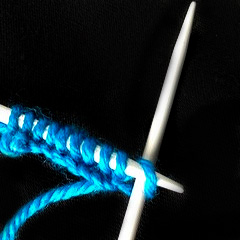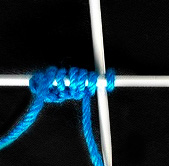By Jenny Hart
There are many ways we can cast on for our knitting projects and some of us have been quite happy using the same method for many years. Creative Fibre tutor Jenny Hart shares her hints on different ways to cast on for that special finesse in your knitting.
Roll Welt for 1×1 Rib
This cast on duplicates the very neat edge used in machine knitting. You are making a narrow, turned hem.
- With smooth waste yarn and using needles two sizes larger than you will use for the ribbing, cast on an uneven number of stitches, being half of the number you require for your project plus one (about 15 for a sampler).
- Using main yarn, purl 1 row, knit 1 row, purl 1 row.
- Using thinner ribbing needles, knit the first stitch, pick up the loop of the main colour from the back of your work. Put it on the LH needle and purl it.
- Knit the next stitch, pick up and purl through the next main loop from below. Continue to the end. (29 sts)
- Pull out the waste yarn anytime.

Open Cast On
The simplest cast on method which makes a row of loops you can pick up later to knit in the opposite direction.
This is a great edge if you haven’t decided what border you want. It makes it easy to start a garment anywhere and work in any direction. Note: knit patterns picked up and worked in the opposite direction will be half a stitch out, i.e. you won’t be able to have an invisible change in rib or a cable. Rib and garter stitch will be invisible. Best result is if you knit (or purl) into the back of the stitch.
- Make a slip knot with your main yarn and place it on the needle.
- Pull some waste yarn through the loop and lay it underneath the needle – don’t let it roll around the needle.
- Hold the waste yarn and slip knot in place then wind the main yarn around both the needle and the waste yarn.
- Knit into the front of the first turn then into the back of all the other turns.
- Slip off any unwanted turns and the slip knot.
- Secure the last stitch with a small safety pin.

Cast on with Single Chain/Double Chain
Single Chain
Single chain is loopy and good for shawls. For a scalloped edge use a double thread for extra strength.
- Make a slip knot and place it on the LH needle.
- Put the tip on the RH needle into the front of the slip loop.
- Knit a stitch and slip the new stitch onto the LH needle without twisting.
 Double Chain
Double Chain
This is a very firm edge best used for non-elastic edges, eg cotton.
- Cast on the stitches by putting the RH needle through both loops of the previous stitch.
- Knit a stitch.
- Place the loop on LH needle without twisting.